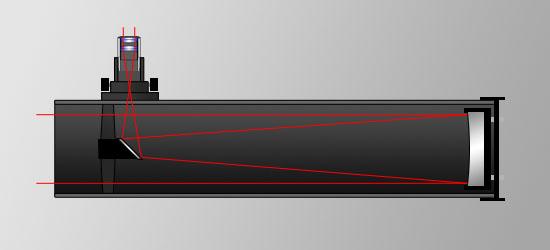
Newtonian Reflectors

Above: Optical layout of a typical Newtonian reflecting telescope
This section details the optical design and inherent aberrations of Newtonian reflecting telescopes. For a more basic overview of this design please see the Newtonian page. For a review of the optical design terms, see the Optical Aberrations and Optical Design sections.
Newtonian Design
The Newtonian was the first reflecting telescope. Despite being one of the simplest optical designs, the Newtonian performs very well and is easy to manufacture so is still one of the most popular telescope types. A concave mirror focuses light, but if the mirror is left spherical the light is not all focused to the same point. This is spherical aberration.

Above: A spherical mirror focuses light rays from different off-axis distances to different points, causing spherical aberration

Above: A parabolic mirror focuses off-axis light rays to a single point
In most Newtonians the mirror is parabolized to eliminate this aberration. However, if the aperture is small enough and the focal ratio large enough, the mirror can be left spherical as the difference between a sphere and parabola is negligible. This is often seen in the common 4.5" f/8 Newtonian popular as a beginner's telescope. However, most Newtonians 5" or larger have parabolic mirrors. A flat secondary is inserted into the optical path to place the focal plane outside the telescope tube in a convenient viewing position. Typical Newtonians have focal ratios from f/4 to f/8.
Newtonian Aberrations
The parabolic shape of the primary mirror eliminates spherical aberration. The main aberration in a Newtonian is coma. Coma is a function of field of view and focal ratio. This limits the useful field and speed of a Newtonian. Newtonians faster than f/4 are rare; in larger sizes (8" and up), f/5 is a more practical limit to keep the star images reasonable. Coma can be reduced with the use of coma-corrector lens, which is usually necessary for wide-field photography. There is some off-axis astigmatism, but this is overwhelmed by the coma. Since the Newtonian is an all-reflecting system there is no chromatic aberration. As with most telescopes, distortion is negligible.

